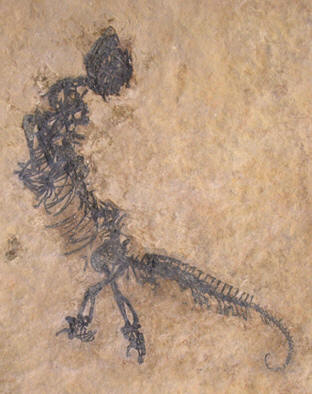
"Vallesaurus"

Discovered in 1975-76, this tiny specimen (about 15 cm long) is the only complete drepanosaurid so far known. It has been named by Rupert Wild, but it is not yet fully described. Despite to this fact, its belonging to drepanosaurids is undisputable. It shares all the caracters of the Drepanosauridae as diagnosed by different authors who published on this group and detailed by myself in my 2000 paper on Megalancosaurus.
Etymology: Dedicated to Prof. Valle
Collected Species: "Vallesaurus cenensis" (Specimen MCSNB 4751 of the Museo Civico di Scienze Naturali Bergamo)
Systematic Palaeontology: Drepanosaurid currently under study
Distribution: Upper strata of the Calcari di Zorzino (Norian Age)
Locality: Cene (Bergamo, Lombardy, Northern Italy)
Repository: Museo Civico di Scienze Naturali "Caffi" di Bergamo
MCSNB 4751 is a small ( about 15 cm long) diapsid reptile with share with the drepanosaurids the following characters: 1) barrel shaped trunk and long, deep, laterally compressed "leaf"-like tail 2) dorsal vertebrae with high neural spines (height of the neural spines approximately four times that of the centrum), 3) anterior dorsal vertebrae anteroposteriorly expanded at their distal end; 4) zygapophyses lying very close to midline; 5) caudal vertebrae in the middle section of the tail with high neural spines and deep haemal spines, at least 40% longer than the neural spines, 6) caudal vertebrae with prezygapophyses overlapping nearly half of the preceding centra; 7) haemal spines attached at the posterior end of the ventral margin of the first 20 caudal centra, 8) ribs mostly holocephalous, slender and triangular in section; 9) gastralia absent; 10): shoulder girdle with a very high, narrow, rod-like scapula, gently bent anteriorly; 11) pelvic girdle with a high iliac blade, a rather narrow pubis and an ischium that is elongate posteriorly; 12) femur shaft not sygmoidal, 13) fifth metatarsal straight (not hooked); 14) penultimate phalanges in both manus and pes at least 50% longer than preceding ones; 15) ungual phalanges with the shape of narrow, very long, and sharp claws, provided with a well developed flexor process.
Now finally the description is out (Renesto & Binelli 2006) so that i can give some info and updates about this little cute critter, just click here!
Artwork by S. Renesto unless otherwise indicated. Please do not reproduce/repost/republish etc. any text or image without asking permission to the author
Home Research Triassic Reptiles